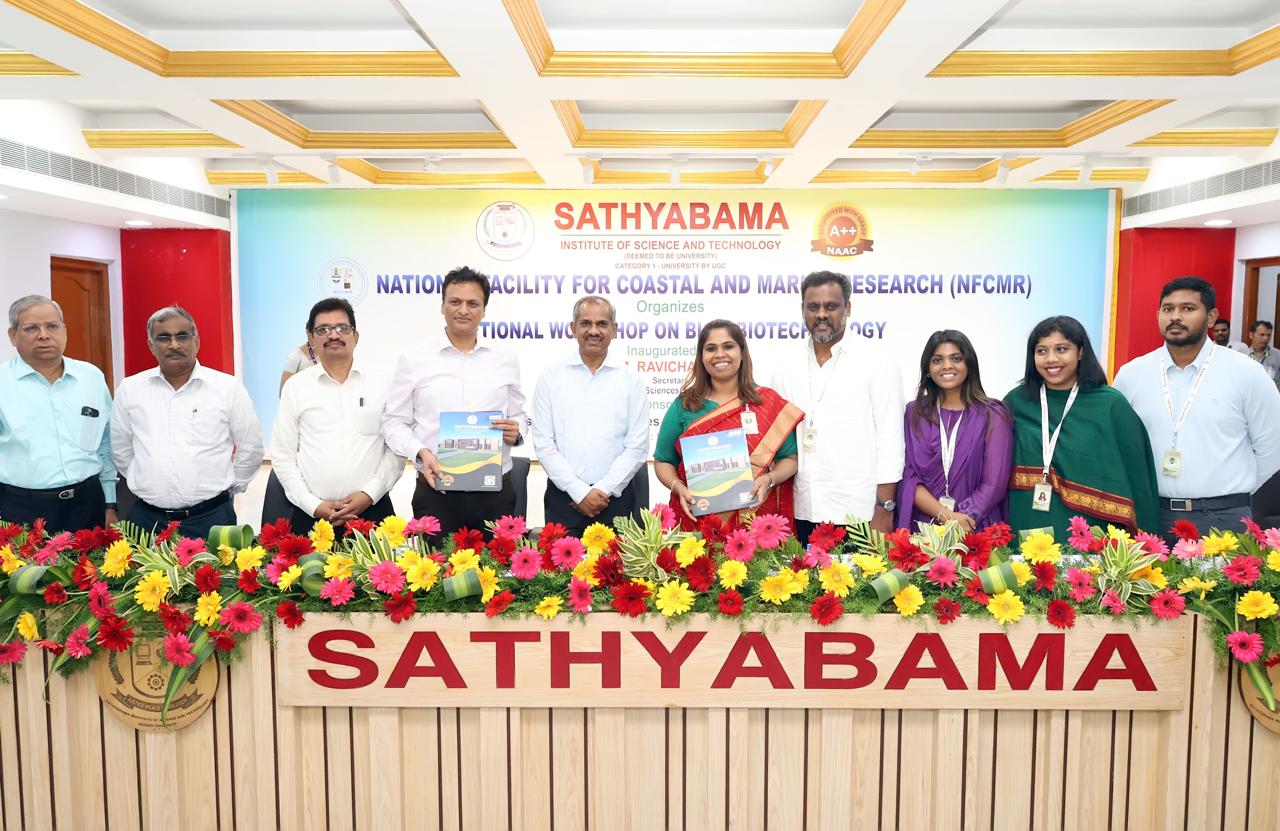Hon’ble MOES Secretary declared the Coastal & Marine Research facility established at the Sathyabama University with National Recognition by signing the MoU and exchanging it with the Hon’ble Chancellor of Sathyabama Institutions
National Facility for Coastal and Marine Research, a centralized hub established in is a pioneering initiative and a first of its kind in the country for advancing the blue biotechnology research, fosters interdisciplinary collaborations. This facility was dedicated by the Hon’ble Chancellor Dr. MARIAZEENA JOHNSON to the students and young researchers with the technical support of the Ministry of Earth Sciences (MoES).
As a mark of the beginning, the National Facility organizes the National Workshop on Blue Biotechnology on 5-6th July 2024, sponsored by MoES which would pave the way for innovative solutions and sustainable practices in blue biotechnology. The Programme is presided by Dr. MARIAZEENA JOHNSON, Hon’ble Chancellor, Dr. MARIE JOHNSON, President, Ms. MARIA BERNADETTE TAMILARASI, Mr. J. ARUL SELVAN and Ms. MARIA CATHERINE JOHNSON, Vice Presidents.
Prof. Dr. M. Ravichandran, Hon’ble Secretary of the Ministry of Earth Sciences (MoES). Dr. G.A. Ramadass, Former Director, NIOT. Dr. M.V. Ramana Murthy. Director, NCCR. Dr. T. Srinivasa Kumar, Director, INCOIS, Dr. G.V.M. Gupta, Director, CMLRE, MOES officials Dr. Gopal lyengar, Scientist G. Dr. Jagvir Singh. Scientist G and other Officials visited the National Facility to explore the state-of-the-art research infrastructure and gain valuable insights.
Hon’ble Secretary declared the facility established at the University with National Recognition by signing the MoU and exchanging it with the Hon’ble Chancellor of Sathyabama Institute of Science and Technology. Collaborations were earmarked by signing of MoUs with INCOIS, BoBP-IGO and various other industries towards Consultancy and Sponsored research projects which were showcased by releasing the sanction orders and work orders.
National Facility for Coastal and Marine Research (NFCMR) is a state-of-the-art facility spanning around 10,000 square feet, equipped with cutting-edge instrumentation and laboratories in marine research and conservation in India. The primary objective includes monitoring marine biodiversity, assessing the impact of pollutants on marine ecosystems, mapping and analysing marine habitats, studying ocean acidification and the effects of climate change, and fostering interdisciplinary collaboration among scientists, researchers, industrialists, and experts.
NFCMR hosts a pivotal National Workshop on Blue Biotechnology, addressing the critical need for innovative marine biotechnology solutions in India. With its vast coastline and rich marine biodiversity, India has immense potential to lead in this field, driving sustainable development through environmental conservation, enhanced marine resources, and economic growth. The workshop highlights the latest advancements and opportunities in blue biotechnology. Aligned with the Sustainable Development Goals and the objectives of the
UN Decade of Ocean Science for Sustainable Development, NFCMR, in collaboration with the Ministry of Earth Sciences, reaffirms its commitment to advancing marine research and fostering innovative solutions for sustainable ocean resource management.
1. Some significant research work done in past 2 years by University:
• Biodiesel from waste cooking oil, Improved the efficiency of Super capacitors and fuel cells
• Conducted ecosystem restoration studies for Balkbay and gulf of Mannar region,
• Novel materials development
• Drug molecules developed for Alzheimer’s disease, TB and HIV and Cardiac disorders
2. Top2% most influential scientist in 2023 , Stanford University List : Analysis of Indian Researchers
• Dr. Murugadoss G- Center for Nano Science And Nanotechnology
• Dr. Prem Jacob T- CSE
• Dr. Sekar Manigandan – Dept Of Aeronautical Engineering
• Dr. Govindaraju K – Center for Ocean Research
• Dr. Jayaseelan C- Center for Ocean Research
3. Arctic to Indian Ocean our scientists
• 2 Scientists in Arctic and Antarctic regions to explore the microbes that withstand extreme low temperature.
• 17+ Scientists are exploring the Indian Ocean Region living and non-living resources in the area of Marine Biology, Remote Sensing and Earth Sciences.
4. Species of fishes discovered- on the whole by our university
• A New Species of the Genus Dendronephthya Kükenthal 1905 (Octocorallia: Alcyonacea: Nephtheidae) and Associated Crustaceans From Covelong,
• 12+ of new species (sea urchin, demersal fishes, polychaete worms and biofilm bacteria) has been reported by Ocean Research.
5. Numbers of products patented- 324
6. Total number of research facility in university- 50+ Major facilities
7. How many 1st of its kind facility in the university— 9
FACS Multi omics core facility, HRTEM, XPS, Confocal RF sputtering, EBeam etc
8. 56% women scientists
9. %age of total women facility-
10. %age of women in leadership –

